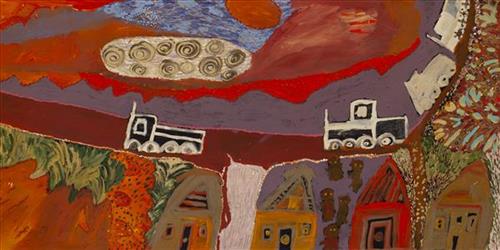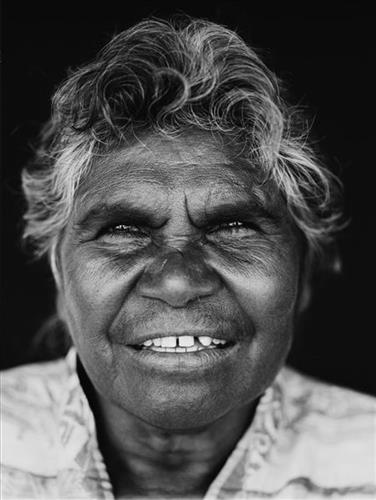111581952788
Puntawarri
“This one Puntawarri. Near Jigalong. Puntawarri. We paint because we go out working there long time. Just working. We’re going out working with the boys, you know? With the boys. KJ [Karninyanpa Jukurrpa Rangers]. We go out. The ladies go out, we camp there. Look for, ah…look for cats’ tracks everywhere, that’s what we do. Looking for cats. We just write it down. Everywhere. Kangaroos, and camels, you know, when we go out? That’s all.
I was working at Puntawarri there, in the house. I got a house there, a big one. We stayed in there a long time. The husbands, my brothers, my sisters. But it’s finished now. The whitefellas. They took everything out, yeah? In Puntawarri. They been stealing, you know? Long time. But it’s finished now. We didn’t stay there. We just go out with the boys and the ladies, yeah. Just work around and camp there sometimes we go there, camping. That’s all.
This is the houses here, yeah? They’re all gone now, the toilets and everything. This long time ago. Yeah long time. It finished now. And that’s the lake, and the flowers. The lake’s full. You walk around everywhere. Take the dogs. Go hunting, but that was long time [ago]. Long time. And the trucks are all coming to work. And all the people, they’re waiting for the truck to jump in! [laughs]. Yuwa.”
– Helen Dale Samson
Puntawarri is an important cultural area located on the middle stretches of the Canning Stock Route and east of the Jigalong Aboriginal Community. It is also the site of a now abandoned community, and a rockhole, waterhole, creek and lake. Puntawarri’s close proximity to Jigalong Mission (now Jigalong Aboriginal community) made it a popular site for Martu to visit and camp at over weekends during the ‘mission days’.
For many Martu, Jigalong Mission was the site where their pujiman (traditional, desert dwelling) lifestyle came to an end from the late 1940s as they transitioned to a life as stockmen and women working in cattle stations in the Pilbara region and beyond. In the wake of the extreme and prolonged drought of the 1960s, the last of the remaining pujimanpa (desert dwellers) were forced to move to missions like Jigalong, where a supply of food and water was assured. There, many Martu were reunited with family members that had already moved in from the desert.
The waterhole at Puntawarri is said to be populated by several kinds of ancestral jila (snake), however the site is best known for its association with the Ngayurnangalku, fearsome ancestral cannibal beings. During the Jukurrpa (Dreaming) the Ngayurnangalku came together from all over the desert, first stopping near Puntawarri on their travels to Kumpupirntily (Kumpupintily, Lake Disappointment). At Kumpupirntily, they had a big meeting to debate whether or not they would continue to live as cannibals, and eventually came to the decision to stop eating people. That night, a female baby cannibal was born to the eastern Ngayurnangalku on the red sandhills at Puntawarri, where she continues to live today as the ‘big mummy’ Ngayurnangalku. Following protocol, the baby also had to be consulted by the group. She determined that the Ngayurnangalku should continue to eat people. Her decision divided the group, and from this point the group from the east continued to live as ‘bad’ cannibals at Kumpupirntily, while the group from the west became ‘good’, thereafter consuming only animals.




